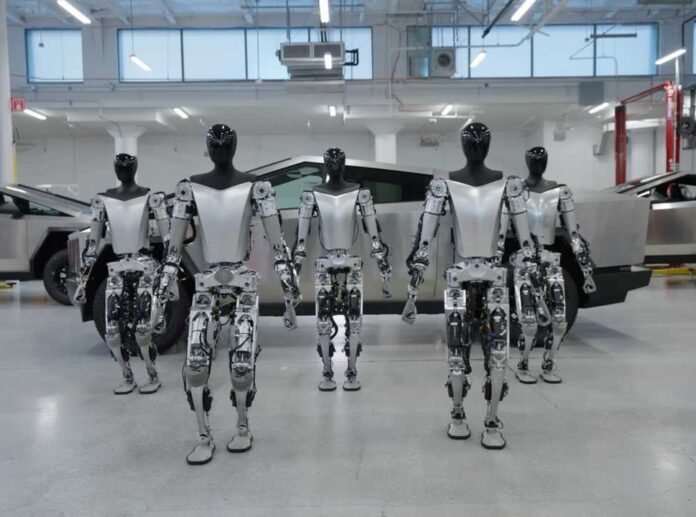Robotics and artificial intelligence (AI) have grabbed online and in print headlines lately. Humanoid robots, in particular, continue to pique media interest. The pursuit of bipedal machines shaped like us is in my mind more about stroking our human ego than practicality.
I will tell you why. When you have a multi-purpose machine to serve as a human assistant, upright on two legs with a high centre of gravity isn’t the smartest design option. Four legs or more is far more stable. A four-legged robot can still have two or more limbs that work like hands. Make the lower limbs flexible and you the robot can squeeze into spaces where a bipedal human would go.
To me, the best argument for humanoid robots is psychological. If robots begin to work en masse beside us then our acceptance of them would be easier if they looked more like us. At least that’s what robotic engineers and some psychologists are saying.
But humans since the 20th century have been working beside and with all kinds of machines that bear no resemblance to us. Do you know a dishwasher that looks human even though it washes dishes or a washing machine that washes clothes? Cars may look a little like wagons but their resemblance to horses is only in horsepower readings. So why the pursuit of humanoid robots? Is this because Mary Shelley wrote Frankenstein, the precursor of stories about human-created automatons? For all their disadvantages, however, the pursuit of humanoid robots is leading to interesting news stories lately. Here are some of them.
A Billion Humanoid Robots on Earth by the 2040s
Elon Musk in a recent interview predicted we would see a billion humanoid robots on Earth by the 2040s and a hundred billion throughout the Solar System (some of them alien) by the 2060s.
Musk believes humanoid robots will eventually outnumber people here on Earth. He is convinced that his Tesla robotic business will outperform his EV operations eventually.
Musk has had his engineering team work on a humanoid robot for several years. It is called Optimus and at a recent Tesla event showed the Gen 2 version doing its thing (see the image above). The demonstration was limited and Musk admitted to having it do more could lead to an embarrassing fall on its face.
Nevertheless, Musk is convinced that as our global population ages, billions of robots will serve to replace human labour. Musk wants Tesla to be at the forefront of this nascent industry building millions while keeping the price down to US $20,000 per unit.
BMW Announces Plans to Build Cars Using Figure 01
Figure is an AI humanoid robotics builder with ambitions to deploy its machines to contribute to the global workforce as human workers become more scarce. Its founder and CEO is Brett Adcock whose mission is to “expand human capabilities through advanced AI.”
Adcock’s rationale for developing a humanoid robot is the growing labour shortage. His company website states, “There are over 10 million unsafe or undesirable jobs in the U.S. alone, and an aging population will only make it increasingly difficult for companies to scale their workforces. As a result, the labour supply growth is set to flatline this century. If we want continued growth, we need more productivity — and this means more automation.”
This month, the Figure 01 humanoid robot made headlines when BMW Manufacturing signed a partnership agreement to deploy it in BMW’s Spartanburg, South Carolina factory, where it will be integrated into the body shop, sheet metal and warehousing operations over the next two years. The Spartanburg BMW plant is the company’s largest, producing 1,500 vehicles daily.
Figure 01 stands 167 centimetres (5.5 feet) tall, weighs 60 kilograms (132 pounds) and can carry 20 kilograms (44 pounds) at a time. It moves at a rate of 1.2 metres (3.9 feet) per second and can operate for five hours before needing a recharge.
BMW isn’t alone in looking at adding humanoid robots to its automotive workforce. Honda, Hyundai, and Tesla, of course, are looking to use them for repetitive and dangerous work on assembly lines.
Can a Bipedal Robot Walk Like Us?
Making a Pinnochio more human isn’t just about shape. It is also about motion. That’s what makes this next story so interesting.
Researchers at Tohoku University in Japan announced this month, they had replicated human-like walking in a bipedal robot. They published their research on decoding how humans walk in the journal, PLoS Computational Biology.
What they created is an algorithm that mimics how our nervous system, bones, joints, muscles, tendons and ligaments all work together in coordination. Associate Professor Dai Owaki described the research in a recent press release.
“Our study has tackled the intricate challenge of replicating efficient walking at various speeds – a cornerstone of the human walking mechanism. These insights are pivotal in pushing the boundaries for understanding human locomotion, adaptation, and efficiency.”
Owaki and his colleagues devised a neural circuit model optimized for energy efficiency over diverse walking speeds. What will this mean for the future of humanoid robotics? Owaki has the answer:
“The successful emulation of variable-speed walking in a musculoskeletal model, combined with sophisticated neural circuitry, marks a pivotal advancement in merging neuroscience, biomechanics, and robotics. It will revolutionize the design and development of high-performance bipedal robots, advanced prosthetic limbs, and state-of-the-art-powered exoskeletons.”
I can imagine builders of humanoid robots wanting to incorporate Tohoku University’s algorithms. There are many more implications to the university’s research that go far beyond bipedal robotics. Being able to replicate the complexity of bipedal walking could lead to new prosthetics and exoskeletons with advanced neural circuitry.
It’s a big deal and may save Musk the embarrassment of watching one of his Optimus robots topple over at a future demonstration.









